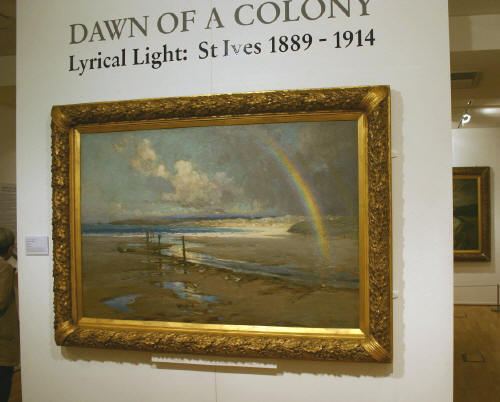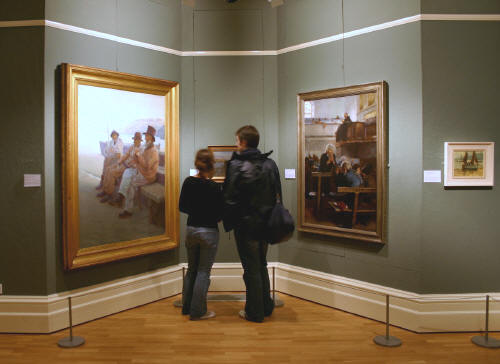|
|
| home | features | exhibitions | interviews | profiles | webprojects | gazetteer | links | archive | forum |
|
Dawn of a Colony
The writer and curator David Tovey describes the story of early St Ives art as told by two complementary Summer 2008 exhibitions
Picturing the West: Tate St Ives 14 June - 13th September
Dawn of a Colony: Picturing the West, St Ives 1811-1888 looks at artists working in St Ives both prior to the establishment of the colony in 1885 and in its formative years. This is not only the first exhibition of early St Ives representational art that Tate St Ives has mounted, but it is also part of a joint project with Penlee House Gallery, Penzance, with that Gallery taking the story of St Ives art up to the First World War, in its exhibition Lyrical Light: St Ives 1889-1914, which opens on 14th June. Both shows run until 13th September.
The completion of the rail link to Penzance in 1859 had a major impact on the number of artists visiting Cornwall and the newly elected Royal Academician, James Clarke Hook, spent nearly three months in St Ives in 1860. Three of his RA exhibits of 1861 were St Ives scenes and the exhibition includes one of these and an etched version of another. In addition to Hook, the exhibition also showcases some major Cornish works by John Brett and Henry Moore, the two leading marine artists of their day, who did much to publicise the attractions of the Cornish coast, and the juxtaposition of these works against the backdrop of the view from the Gallery makes a special combination.
The collapse of the mining industry in the 1870s led to St Ives needing to re-invent itself as a ‘health resort’, but, despite at last getting a rail connection in 1877, it took some time for it to lose its tag as “a dirty fishing town”. However, by the early 1880s, the number of artists visiting increased and, of course, James Whistler, and his two pupils, Walter Sickert and Mortimer Menpes, stayed during January 1884. Some examples of their work are included in the exhibition. However, the establishment of the colony in the winter of 1885 resulted from the visits of the French artist, Émile-Louis Vernier, who alerted various artists in the Breton art colony of Concarneau to the attractions of St Ives. First to arrive and settle in the town were Henry Harewood Robinson and his Irish wife, Dorothy, and they were joined in 1886 by a party of Americans, led by Edward Simmons. Also in St Ives in the summer of 1886 was Stanhope Forbes, and his new Canadian fiancée, Elizabeth Armstrong, and Forbes’ depiction of a house in Digey Square (now Bumbles Café), entitled Their Daily Bread, is included in the exhibition, along with his sketch of bathers and bathing tents on Porthminster beach.
The group of artists that painted together in St Ives in 1886 enjoyed their time so much that they returned in 1887, with further friends from Brittany, including Adrian Stokes, who had shared a studio in Concarneau with Edward Simmons, and his Austrian wife, Marianne. Marianne invited her friend, Helene Schjerfbeck, a Finnish girl that she had met in Paris, to join them in St Ives, and, as Helene did not speak much English, they tended to work together, sharing the same models. One of these was later described by Adrian Stokes as the best child model that his wife ever had, as, because she was so naughty at school, her teachers were delighted when she stayed away! This girl featured in Schjerfbeck’s celebrated St Ives painting, The Convalescent, and a profile of her by Schjerfbeck is included in the exhibition, along with a painting of Chicken Amongst Corn Stooks, originally owned by Adrian Stokes, that has recently been bought by Penlee House Gallery & Museum, Penzance.
1888, the year that brings to an end the Tate show, saw the fledgling art colony in St Ives achieve remarkable success. Helene Schjerfbeck’s The Convalescent was bought by the Finnish Art Society, Anders Zorn’s Fisherman, St Ives won a Mention Honorable at the Paris Salon and was bought by the French Government and Adrian Stokes’ Upland and Sky (included in the exhibition) became the first painting by a St Ives resident to be bought for the nation by the Chantrey Trustees. When, the following year, St Ives works by Adrian Stokes, Edward Simmons, Howard Russell Butler and Helene Schjerfbeck won medals at the Paris World Exposition, which, as it marked the centenary of the French Revolution, was the most prestigious exhibition of the decade, the art colony at St Ives had secured for itself a significant reputation on the international stage, which was only to grow over the next quarter century - the period covered by this summer’s shows.
Lyrical Light: Penlee House 14 June - 13th September The second, and most significant, part of the Dawn of a Colony joint project between Tate St Ives and Penlee House Gallery, Penzance, entitled Lyrical Light; St Ives (1889-1914), opens at Penlee House on 14th June. This highlights, in particular, how St Ives became a world-renowned centre for both the practice and teaching of landscape and marine painting during this period, as is demonstrated by the fact that a good many of the exhibits were shown, at the time, in international exhibitions in Paris, Brussels, Chicago, Pittsburgh, St Louis and even Buenos Aires.
Stokes’ paintings drew down to St Ives a number of budding landscape students from the Herkomer Art School at Bushey, including Arnesby Brown, Arthur Meade, Algernon Talmage and Greville Morris. Arnesby Brown, who, in his day, was considered to be “the greatest English landscape painter since Constable”, is represented in the exhibition by five works, including three magical depictions of the harbour at St Ives, as evening draws in, with the lights from the town playing across the gently lapping waters. Brown, on his early visits to the town, stayed and painted at Tregethas Farm, near St Erth, which is still owned by the same family, the Hockings, that welcomed him then, and the show at Penlee House includes Brown’s 1896 Royal Academy exhibit, Homeward, depicting cattle returning to the farm at twilight. Considered at the time his best work yet, it is very typical of the Barbizon-inspired work of the St Ives landscapists of this period, leading them to be called ‘The School of Moonrises’.
During this period, flat and gently curving lines in landscape were felt to evoke moods of restfulness and the Marazion Marshes were an enduring source of inspiration for all the St Ives landscapists, and marshland scenes, in which the pools of water reflect interesting lighting or cloud effects, by Louis Grier, John Noble Barlow and Adrian Stokes are also included in the exhibition. Regular visitor, Alfred East, was also an important influence in the colony and he is represented by his major work, Hayle from Lelant (RA 1892), painted from Lelant Station and showing the mackerel boats laid up, out of season, in the Hayle Estuary. Julius Olsson, who became known as Britain’s greatest seascape painter, produced the finest work of his career in St Ives, particularly in the years 1900-1914, and he is represented by four works, including Moonlit Shore, the painting that secured his reputation in this country when it was bought by the Chantrey Trustess in 1911, and Stormy Evening on the Cornish Coast (RA 1912), a large, impressive canvas combining two of Olsson’s favourite themes - storm and sunset. Vividly coloured, these works, with their aura of romance, finally made pure seascapes acceptable in Britain.
Another painting that has been specifically restored for this exhibition is Moffat Lindner’s The Flowing Tide, again a depiction of sunset off Porthmeor and a work that won an award at Pittsburgh (1905). However, perhaps the most successful marine artist in St Ives in the 1890s was Edmund Fuller, for he pandered to the Victorian love of dramatic incident. A Last Hope, therefore, features a lifeboat off to save the crew of a doomed ship, but, in reality, this is a magnificent wave painting.
St
Ives also boasted its fair share of fine figure painters. William
Titcomb is represented by his well-known works, Old Sea Dogs,
medalled in Chicago in 1893 and bought by Nottingham Castle Museum from
the seminal exhibition of Cornish Art held there in 1894, and
Primitive Methodists at Prayer, St Ives, his world-famous depiction
of the fervour of the fishermen in the Fore Street Chapel, which won
medals in Paris, Chicago, Brussels and at the Franco-British exhibition
of 1908. Marianne Stokes is represented by the much loved
The highlight of the watercolour section is John Bromley’s The Harbour, St Ives, a massive work painted from his home, Quay House, which was exhibited at the International Exhibition in Buenos Aires in 1910, and there are contributions to this section from artists such as Charles Mottram, Moulton Foweraker and Arthur White, whilst etchings by Alfred Hartley and Alfred East are also included. It is hoped to find space to hang work by some of the many visiting foreign artists, who did so much to promote the reputation of the colony on the world stage, such as the Americans Elmer Schofield, Guy Carleton Wiggins, Frank Hutton Shill and George McCord, the Canadian Harry Britton, the New Zealander Herbert Babbage and the Australians Will Osborn, Will Ashton and Richard Hayley Lever, the latter being perhaps the most innovative artist working in St Ives in this period. The exhibition, which runs until 13th September, should result in a complete re-evaluation of the place of early St Ives art, not only in the history of Cornish art, but also in national and international contexts.
David Tovey’s new book St Ives Art pre-1890 - The Dawn of the Colony (price: £12-95) is available at the Tate St Ives bookshop, tel 01736 791110 . David Tovey’s second new book Pioneers of St Ives Art at Home and Abroad (1889-1914) is available at the bookshop at Tate St Ives and The Harbour Bookshop in Tregenna Place and, of course, at Penlee House (Price £35).
|
|
|


